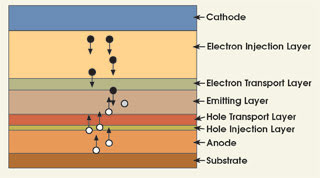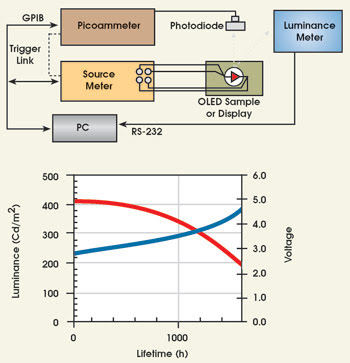Charles Cimino, Keithley Instruments Inc.
Organic LED displays employ an emerging light-emissive technology for efficiently converting electrons into visible light spectrum photons. Such devices have multiple layers composed of a wide variety of organic materials.
In a typical display, individual organic LEDs form an array, or matrix, of pixels, which are combined in a row-and-column configuration. A typical color display has RGB (red, green, blue) pixels arranged adjacently so that color mixing by the eye enables the reproduction of any visible color combination. Minimizing or controlling brightness variations in each primary color emitter is key to a high-quality, accurate color display.

The basic organic LED physical structure has layers of organic materials that work with each other to form various junctions that emit colored light when injected carriers recombine through fluorescence and, increasingly, phosphorescence mechanisms.
Although large gains continue to be made in organic LED material and device lifetimes, much testing and development remain to be done, particularly with blue materials and devices. Because of the higher energy levels associated with blue emission and other factors, lifetimes of such devices lag behind those of red, green and other colors. The best way to improve lifetime is through careful testing under various electrical and environmental conditions, primarily through the use of DC and pulsedcurrent modes of operation. Electron flow directly creates photon emission, so careful control of current sourcing and synchronized measurement of junction voltage and light output are required.
Passive-matrix organic LED displays, the simplest and least expensive matrix displays, have size and performance limitations because of their need for constant refreshing of rows and columns. And, because individual pixels operate in pulsed modes with on-to-off duty cycles as low as a few percent, they must be driven extremely hard to achieve acceptable overall display brightness. Active-matrix displays, on the other hand, do not require pulsed operation and have 100 percent duty cycles, so average and peak brightness levels are identical. Typically, active-matrix organic LED lifetime testing uses DC, while passive-matrix testing is done with pulsed current to better simulate operating conditions.
In both cases, there often are complex needs for voltage and current level and timing control to enhance turn-on and turn-off speeds. They are met by voltage precharging and by applying reverse bias voltages to sweep the charges or clear leakage paths. Therefore, the test system requires source and measuring instruments capable of intricate timing and precise DC and pulsed output levels, coupled with equally precise synchronized voltage and light measurements.
Basic organic LED device performance such as brightness decay or lifetime to 50 percent (L50) or 90 percent (L90) can be measured with a DC or pulsed-constant light-current-voltage (LIV) test. This test uses forward bias constant current sourcing with high-speed voltage and light measurement during a single pulse. Pulsed testing of longer-term characteristics requires continuous pulse trains with sampled measurements at regular intervals of minutes to hours.

In pulsed applications, the luminance meter within a modular LIV test system will average the light output, while the photodiode peaks must be sampled andmathematically averaged to determine long-term trends and changes.
Modular LIV systems can include a calibrated luminance meter for calibrated light measurements, but a photodiode alone will work in most applications because percentage change from initial brightness is sufficient. The relationship of increasing voltage to decreasing light over time is also of interest in calculating end-of-life efficiencies.
For most applications, including lifetime decay, efficiency, brightness and other basic performance testing, a simple, inexpensive photodiode detector will work for both DC and pulsed LIV measurements. Photopic filtered detectors are available when various wavelength devices are being tested and human eye correlation is important. Unfiltered detectors are more sensitive and less expensive, and can be manually corrected for spectral response, as long as the specific output color is sampled for a given material.
The fixturing of the device under test often requires custom dark-box and detector positioning designs. These designs should assure minimum light interference from ambient sources and repeatable optical coupling between the emission source and detector.
During R&D and production, electrical characterization of a display may include current and voltage performance of the organic LEDs, reverse bias leakage current and open/short testing of individual display pixels as well.
Although an organic LED’s current and voltage characteristics roughly approximate those of a conventional semiconductor diode, the former has much less carrier mobility because of the disordered nature of organic materials. The resulting formation of space charges produces numerous transient effects, some of which cover multiple orders of magnitude in time.
Current hysteresis resulting from the direction and speed of the sweep voltage is also present. These effects must be properly characterized and understood before laser manufacturers can correlate pulsed and DC test results with the performance and reliability of a display.
Understanding key organic LED materials and device performance parameters, as well as the best ways to test and analyze performance, are crucial for making high-quality displays. Success also requires careful design of testing systems and methodologies, including instrument selection and integration. Matching test variables as closely as possible to actual operating conditions will enable accurate models and predictions for emerging organic LED color displays.
Contact: Charles Cimino, senior marketing business manager, flat panel displays, Keithley Instruments Inc., Cleveland; e-mail: [email protected].